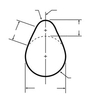Cylinder Head Recon Pt1 Flashcards


A head with intake and exhaust ports on OPPOSITE sides is called
Crossflow
If the contact made by a valve face and valve seat is too wide or too thin what problem can this cause?
Burning of the valve face / seat => loss of seal
2 main materials for cylinder heads
Aluminium and cast iron
3 types of fit methods
- Interference - hole is smaller than insert, held in place by pressure
- Clearance - has a clearance to allow for expansion
- Neutral / transition - just touching, will allow expansion but not very much
Easiest way to test spring squareness
Roll on a flat surface. If rolls in a straight line, it’s square. If rolls in an arc then it’s bent.
4 reasons to machine a cylinder head
- Make the sealing surface flat so the gasket will seal properly
- Raise the compression ratio
- Square the head to the block
- After welding, straightening or crack repair
3 kinds of valve guide seals

Umbrella, positive locking, GM / o-ring

If a cylinder head is warped / bent what should be done about this
Will need to be straightened before it can be machined OR probably better off just replacing it.
What causes coking
Worn / damaged valve seal or guide
What valve clearance is required for hydraulic lifters?
Zero - hydraulic lifters adjust to maintain zero clearance at all times.
3 timing belt profiles
- Round tooth
- Gilmar
- Trapezoidal
6 steps to check a cylinder head for servicability
- Visually inspect for corrosion and damage
- Hardness test
- Crack test
- Check if any parts undersized due to previous machining
- Check for warpage / bending
- Check for broken studs / threads
When changing a timing belt, what else should be checked
Make sure the oil seals will last the life of the new belt. If not, change the oil seals as well.
4 tests performed on valve springs
- Freestanding height test
- Spring squareness
- Open close spring pressure test
- Collapsed spring height
Where in a valve does the greatest heat transfer take place?
Where the face touches the seat
Why is compression limited in petrol engines?
Higher compression => higher temperature. At a certain temp the flashpoint of petrol will be reached => uncontrolled explosion instead of controlled burn.
2 advantages of using cast iron for cylinder heads
- Stronger
- Porous so absorbs oil => allows for boundary lubrication
What problem can be caused by a valve not seating properly
Inadequate heat transfer can => burnt valve and loss of airtight seal => loss of power
Is lash clearance bigger on intake or exhaust
Exhaust - more heat => more expansion
Flame propagation
The speed at which flame moves within a combustion chamber.
What is coking
Build up of oil that has been heated enough to burn but not enough to ignite.
In what direction to all engines turn
Clockwise
What are the 2 main effects of valve rotators
- Reduce carbon buildup
- Reduce hot spots
Another name for tappet adjuster
Cam lifter
If the contact point between the valve and seat is too HIGH, what should be done to adjust this.
Crown cut the valve seat.
When doing a compression test - hissing coming from the exhaust indicates?
Exhaust valve not sealing properly
3 problems that can occur with valve guides
- Indadequate lubrication
- Geometry problem
- Wrong stem to guide clearance (e.g. too loose)












